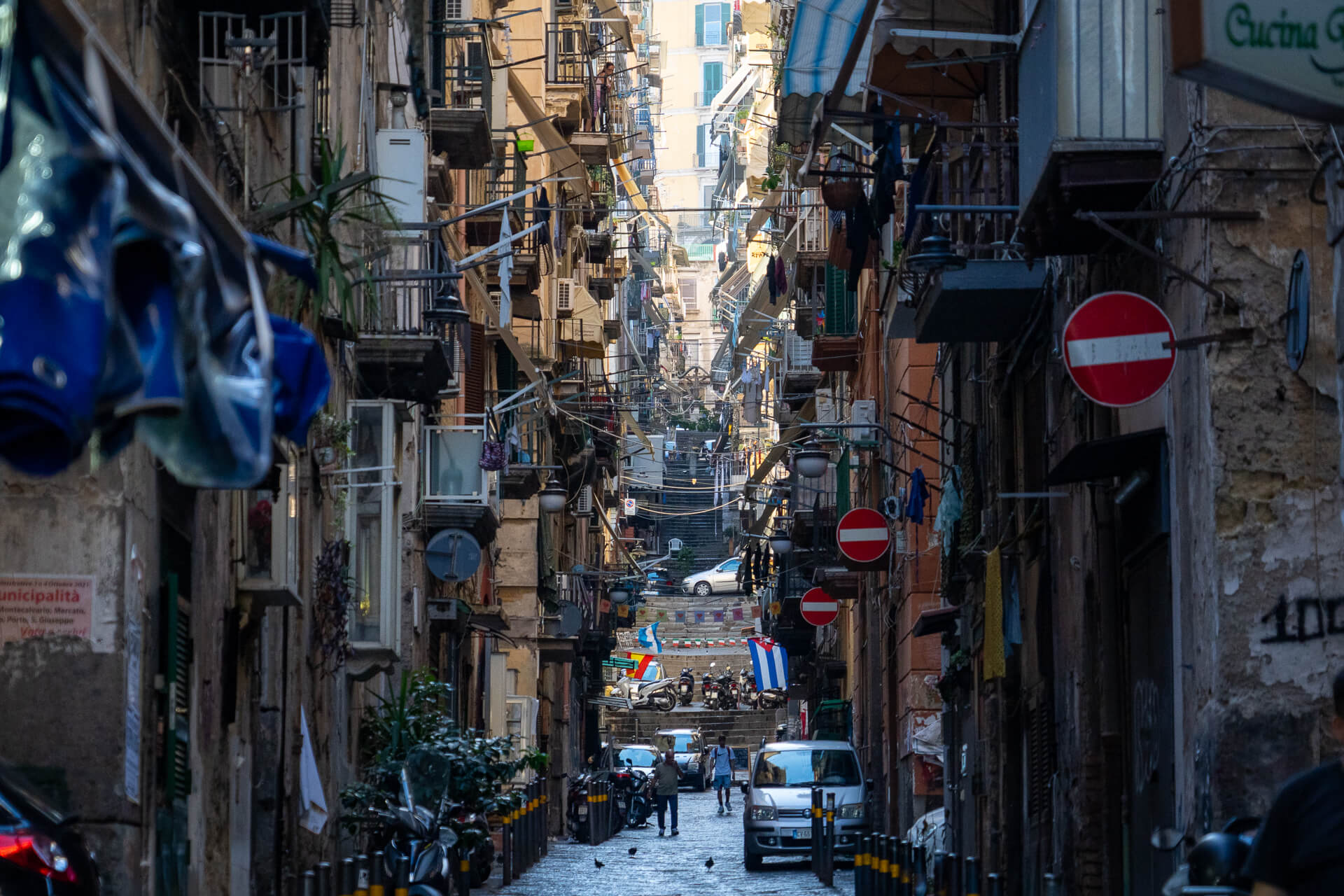This article contains affiliate links. Learn more in our affiliate disclosure.
Our trip to Naples, Italy, wasn’t planned at all. We were actually supposed to be on our way to Iceland, but bad weather had other ideas. After our flight got diverted to Bari and we missed the connection, we decided to make the most of it and spend a few unexpected days — and honestly, it turned out to be one of the best surprises of the year.
We didn’t expect much from this city, but it has a way of pulling you in fast — with its chaotic streets, crumbling beauty, and food so good it makes you forget every other pizza you’ve ever had.
Of course, Naples isn’t perfect — the city can feel rough, and yes, there’s quite a bit of garbage around. Locals also warned us to be mindful of our belongings, as petty thefts can happen even during the day. However, none of that really takes away from its energy or charm.
Luckily, Nika (who’s an unbelievably fast and efficient planner — I truly admire her for that) had actually been to Naples before we met, so she already knew her way around. Within just two hours, she pulled together a full itinerary so we could experience as much as possible.
If you’re planning a trip here, expect a city that’s raw, energetic, and full of contrasts — royal palaces next to graffiti-covered alleys, sunsets over the bay, and locals who make you feel like you’ve known them for years.
In this post, we’re sharing the best things to do in Naples based on our own experience — from iconic landmarks and pizza spots to the best places for day trips.
You’ll also find tips on where to eat, how to get around, the best time to visit, and local insights to help you make the most of your trip.
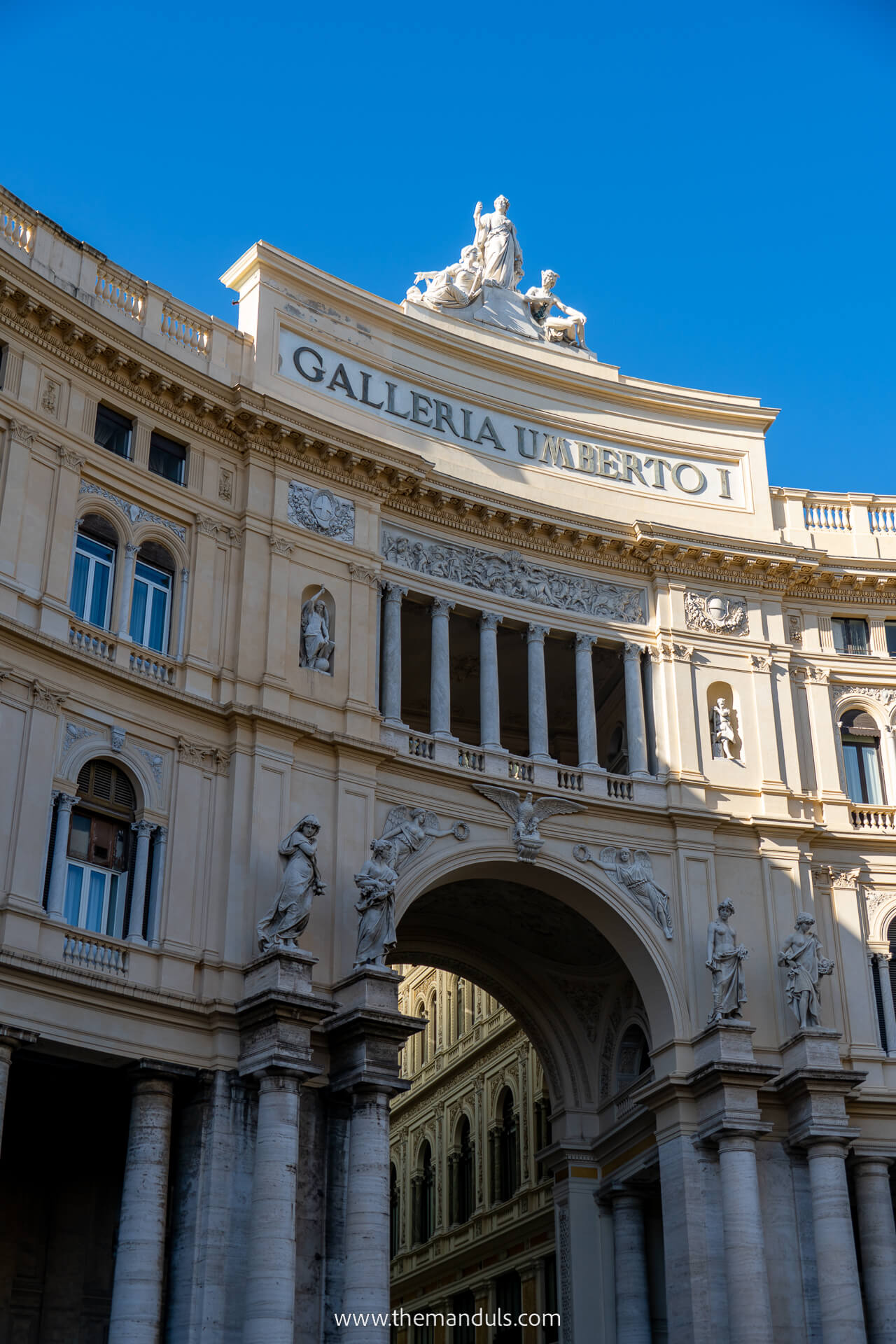
Top Things to do in Naples
Map of all the attractions
1. Walk down Spaccanapoli
This quickly became our favorite part of Naples. Unlike other areas of the city, it feels a little more organized and less chaotic — though still full of life in that perfectly Neapolitan way. The narrow lanes stretch endlessly through the old town, with colorful laundry hanging overhead and locals chatting across balconies.
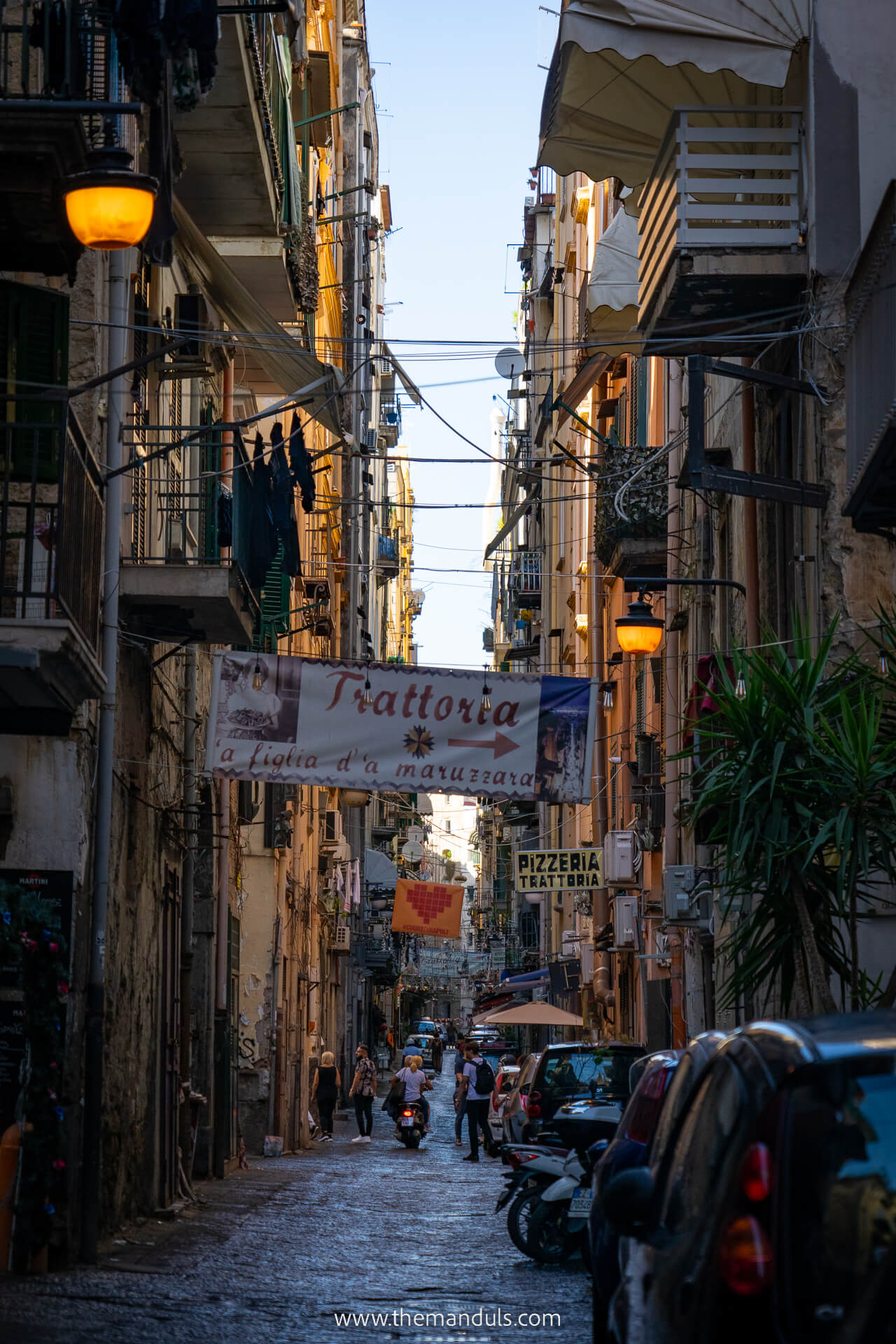
As you wander, you’ll pass tiny cafés, family-run restaurants, and street food stands serving some of the best seafood you’ll find in the city. Definitely try the fresh calamari or fried anchovies — they’re a local delicacy.
If you’re looking for a great meal in the area, we highly recommend Cala La Pasta — a cozy spot serving homemade pasta with generous portions and authentic flavors.
We loved stopping for a quick Aperol Spritz or a glass of Limoncello at one of the small corner bars — most places charge just €2–€3, making it dangerously easy to turn a short walk into a lazy afternoon.
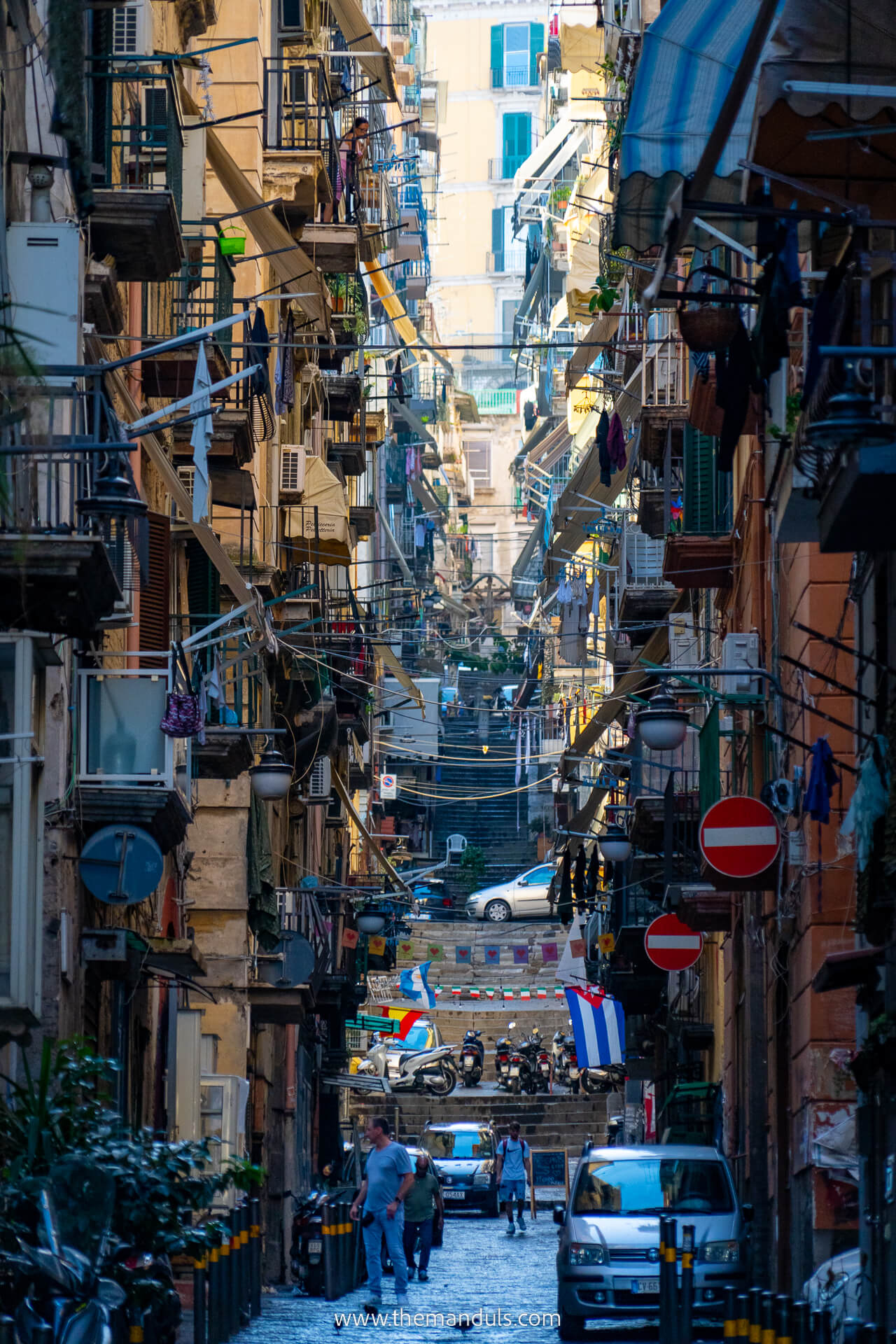
While exploring Spaccanapoli, don’t miss these spots:
- Duomo di Santa Maria Assunta – the city’s main cathedral and one of Naples’ most impressive churches.
- Via dei Tribunali – lively historic street packed with local eateries and pizzerias.
- Gesù Nuovo Church – easily recognized by its unusual diamond-patterned facade and stunning interior.
What we like about these churches is that they are completely free to enter, making them easy to explore.
2. Visit Piazza del Plebiscito
Piazza del Plebiscito is one of those places that instantly makes you stop and stare. Surrounded by elegant buildings and open views all the way to the bay, it’s where Naples shows its grand and graceful side — a nice contrast to the city’s usual chaos.
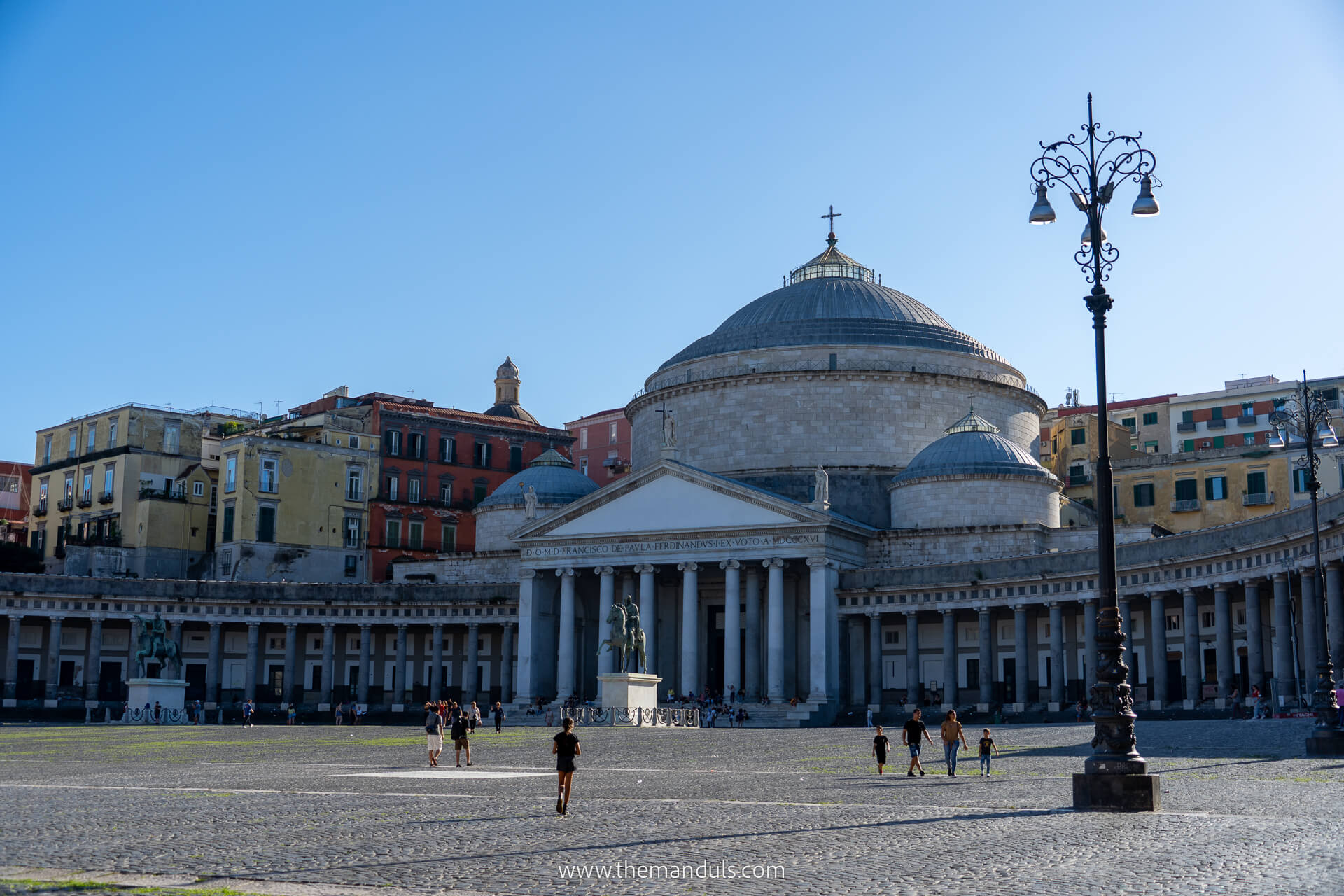
The square is framed by two of the most important landmarks: the Royal Palace on one side and the Basilica of San Francesco di Paola on the other. Both are worth stepping into if you have time, but even just standing in front of them feels impressive.
We stopped by both during the day and later at night, and it almost looked and felt different. During the day, it’s bright and lively, and at night, the buildings are lit up in various colors, and the atmosphere completely changes.
From here, it’s an easy walk to Castel Nuovo, Teatro di San Carlo, and the waterfront promenade, so it’s a great central stop to plan around during your day.
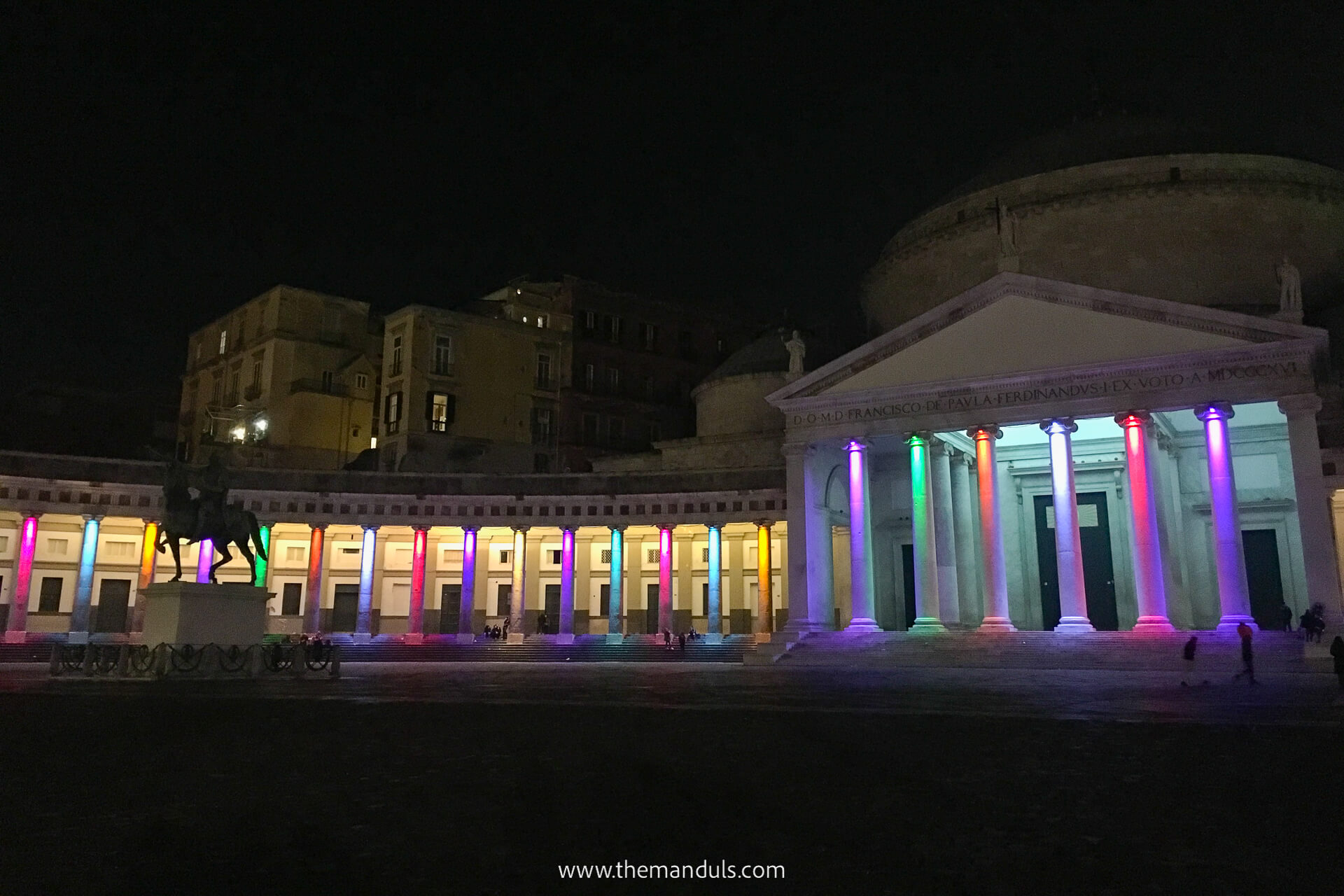
3. Visit Castel Nuovo (Maschio Angioino)
Entrance Fee: €6 per person
Opening hours: Monday to Saturday from 9 AM to 6:00 PM
You can’t really miss Castel Nuovo — it’s the massive stone fortress right by the port, with five round towers that look straight out of a medieval movie.
We walked past it a few times, stopping each time to admire it from different angles. It’s one of those landmarks that looks even more impressive in person, especially with Mount Vesuvius in the background.

We didn’t actually go inside — we’re not huge museum people — but if you are, it’s worth a visit. Inside, you’ll find a mix of history and art, including royal tombs, sculptures, and frescoes. There’s also an inner courtyard and panoramic views over the bay from the upper floors.
What we liked most is how central it is. You can easily combine a stop here with Piazza del Plebiscito, the Teatro di San Carlo, or a walk along the waterfront promenade — all are just a few minutes away.
An hour is usually enough to explore. The light is best in the late afternoon if you want to photograph it from the outside.
4. Try Authentic Neapolitan Pizza
With so many pizzerias, it’s honestly hard to know where to start — there are hundreds, and nearly all of them claim to be the best.
Eating pizza is definitely one of the best things to do in Naples, and we ended up choosing one of the city’s most historic spots, Antica Port’Alba, which is actually considered the oldest pizzeria in the world, having served pizzas since 1738.
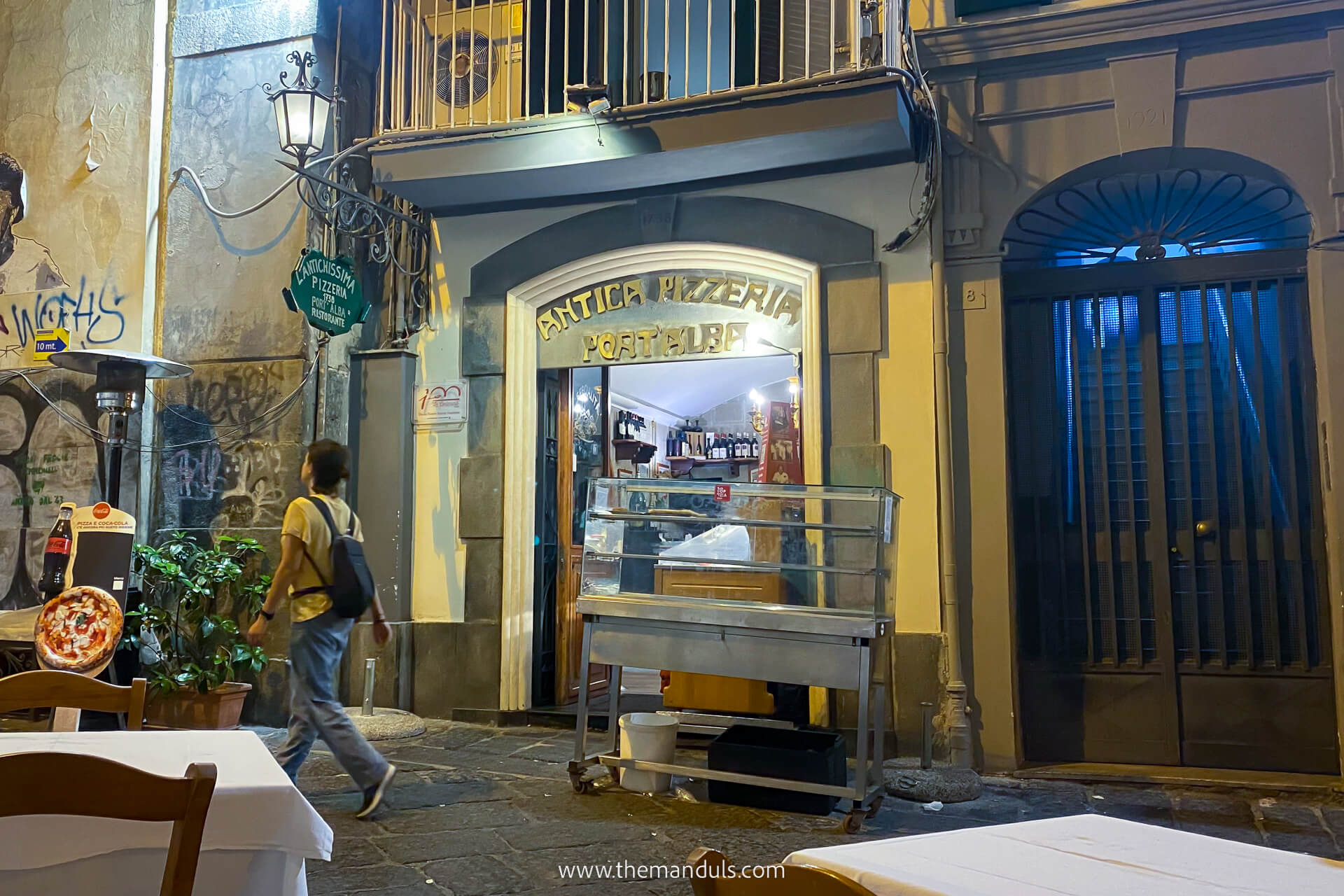
The place feels wonderfully old-school — simple decor, quick service, and that classic Neapolitan energy. What surprised us most was the menu — there are around 70 different types of pizza, from the traditional Margherita to more creative toppings we’d never seen before.
To secure a table, we recommend making a reservation in advance, especially for dinner. Otherwise, coming close to closing time works too — that’s how we managed to get a seat without waiting.

Even though we didn’t have time to try many others this trip, these are the pizzerias we’re saving for next time and would love to try them all.
- Pizzeria e Trattoria del Purgatorio
- Gino e Toto Sorbillo
- L’Antica Pizzeria da Michele
- Pizzeria Da Attilio
- Pizzeria Santa Maradona
Tip: Pizzas in Naples come unsliced, so don’t be mad — it’s just the traditional way of serving.
5. Try Gelato
In Italy, you’ll find delicious gelato on almost every corner — and this city is no exception. So don’t hold back and try a few different places while you’re here!
The one that really stuck in our memory was Mennella Il Gelato on Via Toledo. And surprisingly, it wasn’t just because of the ice cream itself — but because of their whipped cream.
With two scoops of gelato, they top it off with a generous portion of their homemade whipped cream, and honestly, we’ve never tasted anything like it. Probably the best whipped cream we’ve ever had in our lives. Try it and judge for yourself.
Here are the gelaterias we saved for our next trip and can’t wait to try:
6. Ride the Metro Line 1 (The Art Metro)
This might sound like an odd recommendation, but trust us — the metro in Naples is worth seeing even if you don’t need to get anywhere. Line 1, known as the Art Metro, is one of the most unique public transport lines in Europe, with each station designed by a different artist or architect.
The one you absolutely shouldn’t miss is Toledo Station. It’s deep underground, covered in glowing blue mosaics that make you feel like you’re walking through an underwater tunnel. We didn’t expect much when we went down, but it ended up being one of the most photogenic (and surprising) places in the city.
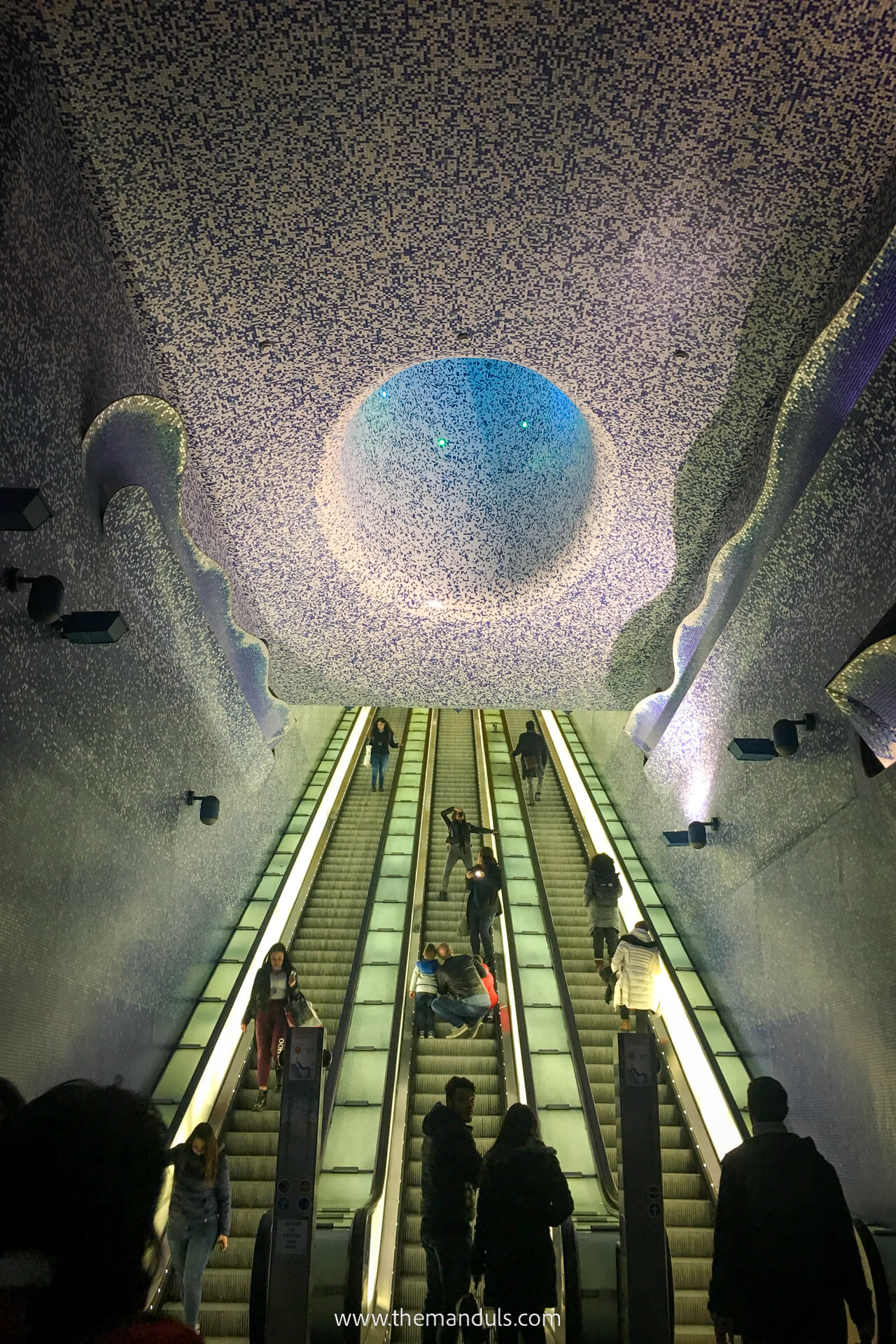
If you’ve got time, also check out Universita Station with its colorful, futuristic design, and Municipio Station, which connects directly to the port area near Castel Nuovo — it’s perfect if you’re heading toward the waterfront or taking a ferry.
A single metro ticket costs around €1.30, and you can usually buy tickets from machines at the station, but they don’t always work. If that happens, look for small stalls or newsstands nearby — most of them also sell metro tickets.
Don’t forget that the subway only runs from 6:00 am to 11:00 pm, so plan your evening trips accordingly.
7. Lungomare promenade
If you need a break from the chaos of the old town, the Lungomare promenade is the perfect escape. Stretching for about three kilometers along the waterfront, it’s one of the most peaceful and scenic parts of the city — wide, open, and lined with palm trees, cafés, and sea-view restaurants.
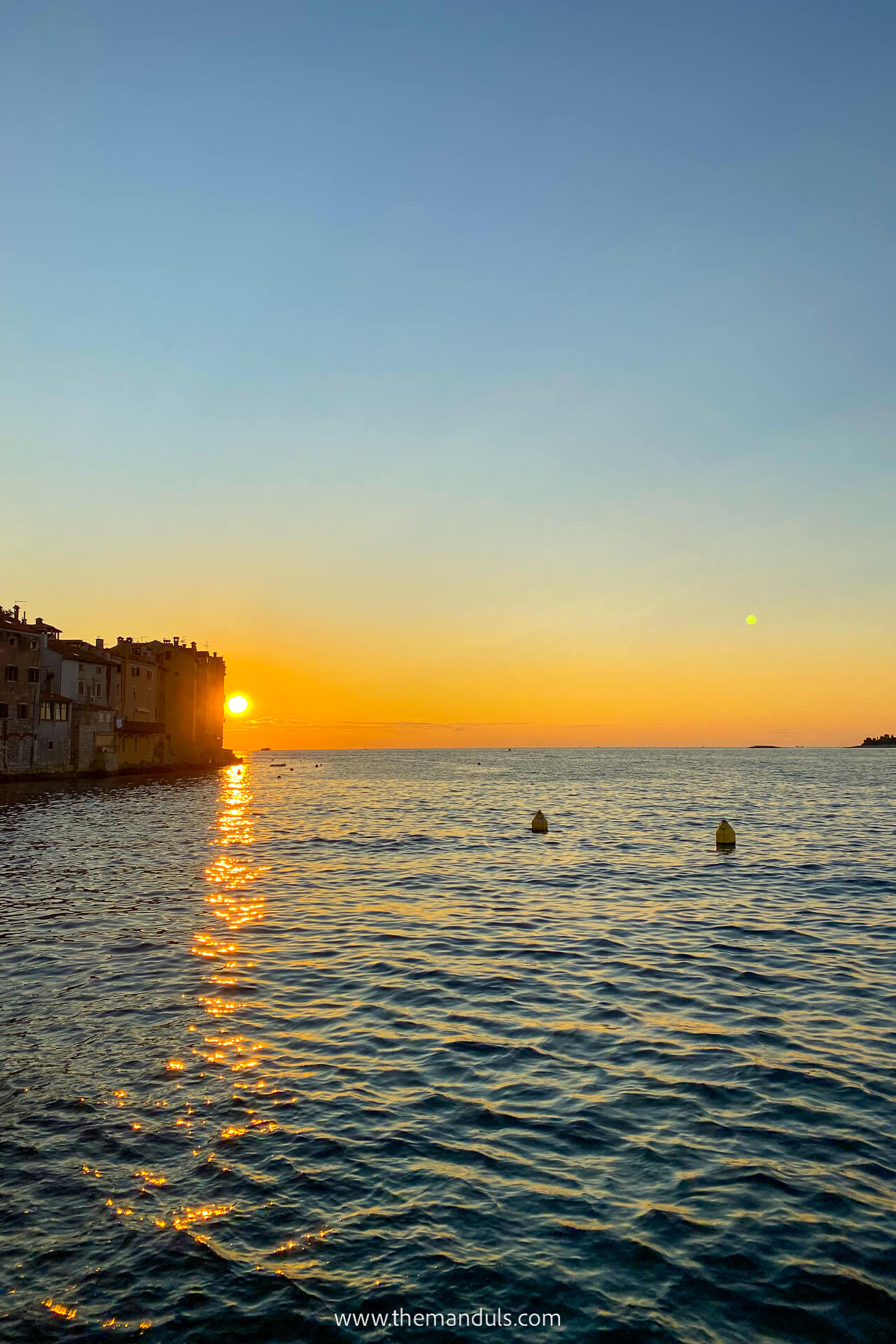
We really enjoyed the late afternoon when the light got softer and the whole bay started to glow. You get postcard views of Mount Vesuvius, the Castel dell’Ovo, and even Capri in the distance on a clear day. It’s an excellent spot for a relaxed walk, morning run, or just to grab a coffee and watch the locals go by.
The atmosphere changes throughout the day — mornings are calm and quiet, while evenings feel more social with people strolling, and musicians setting up along the promenade.
8. Castel Sant’Elmo & Certosa di San Martino (Sunset Viewpoint)
For the best panoramic view of Naples, head up to Castel Sant’Elmo and the nearby Certosa di San Martino in the Vomero district.
It’s one of those spots that makes you realize just how huge and dramatic this city really is — the sprawl of rooftops, the curve of the bay, and Mount Vesuvius rising perfectly in the background.
We took the funicular up from the center, which already felt like an experience on its own, winding through residential streets and opening up to incredible views.
Once at the top, you can easily walk between the two landmarks — the castle offers wide terraces and unbeatable photo spots, while the monastery is quieter, filled with courtyards, gardens, and a surprisingly rich museum.
The funicular costs around €1.30, and both places are open until late afternoon.
9. Visit the Naples Cathedral (Duomo di San Gennaro)
We somehow managed to miss the Naples Cathedral during our trip — and only realized it once we had already left the city. It’s one of those moments where you look back at your photos, spot the Duomo on someone else’s feed, and think: how did we skip that?
The Duomo di San Gennaro is one of Naples’ most important landmarks and a key part of local life. It’s dedicated to the city’s patron saint, whose relics are said to protect Naples from disaster — locals take this seriously, especially during the annual “miracle of the blood” ceremony when crowds gather to see if the saint’s blood liquefies (a big deal here).
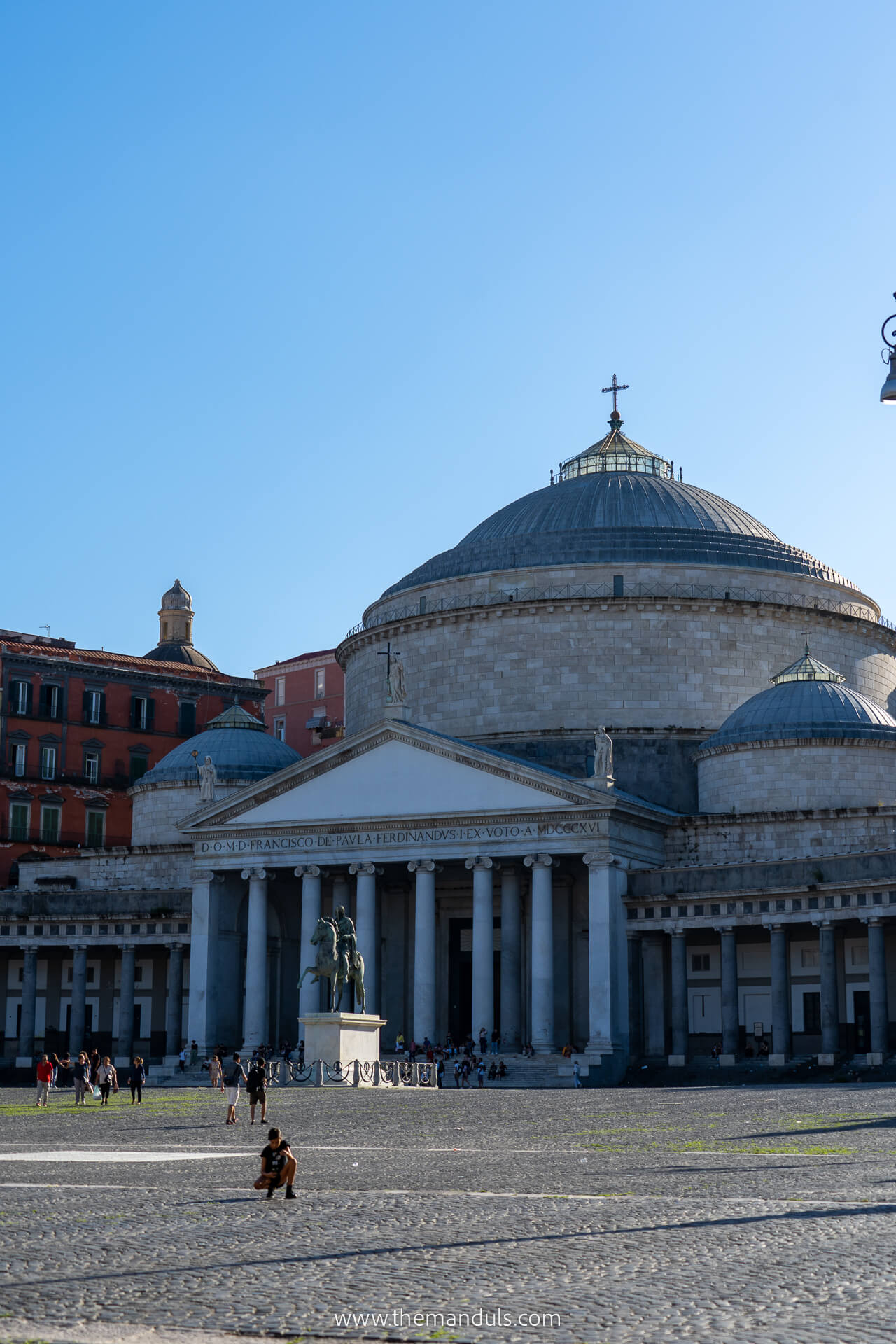
Even though we didn’t make it inside this time, it’s high on our list for our next visit. The interior looks stunning in photos — grand arches, marble columns, and intricate frescoes that show just how deep Naples’ history runs.
Tip: The Duomo is free to enter and open most of the day. It’s located just off Via dei Tribunali, so it’s easy to combine with a walk through the historic center.
10. Climb Mount Vesuvius
Even though we didn’t climb Mount Vesuvius together during our trip, Nika had visited it before we met — and she still says it’s one of the most impressive experiences near Naples. So it’s high on our list for next time, and we’ll definitely come prepared for it.
The volcano sits just outside the city and is easy to visit on a day trip. You can drive or join an organized tour that takes you almost to the top, with the final stretch being a short but steep hike up to the crater.
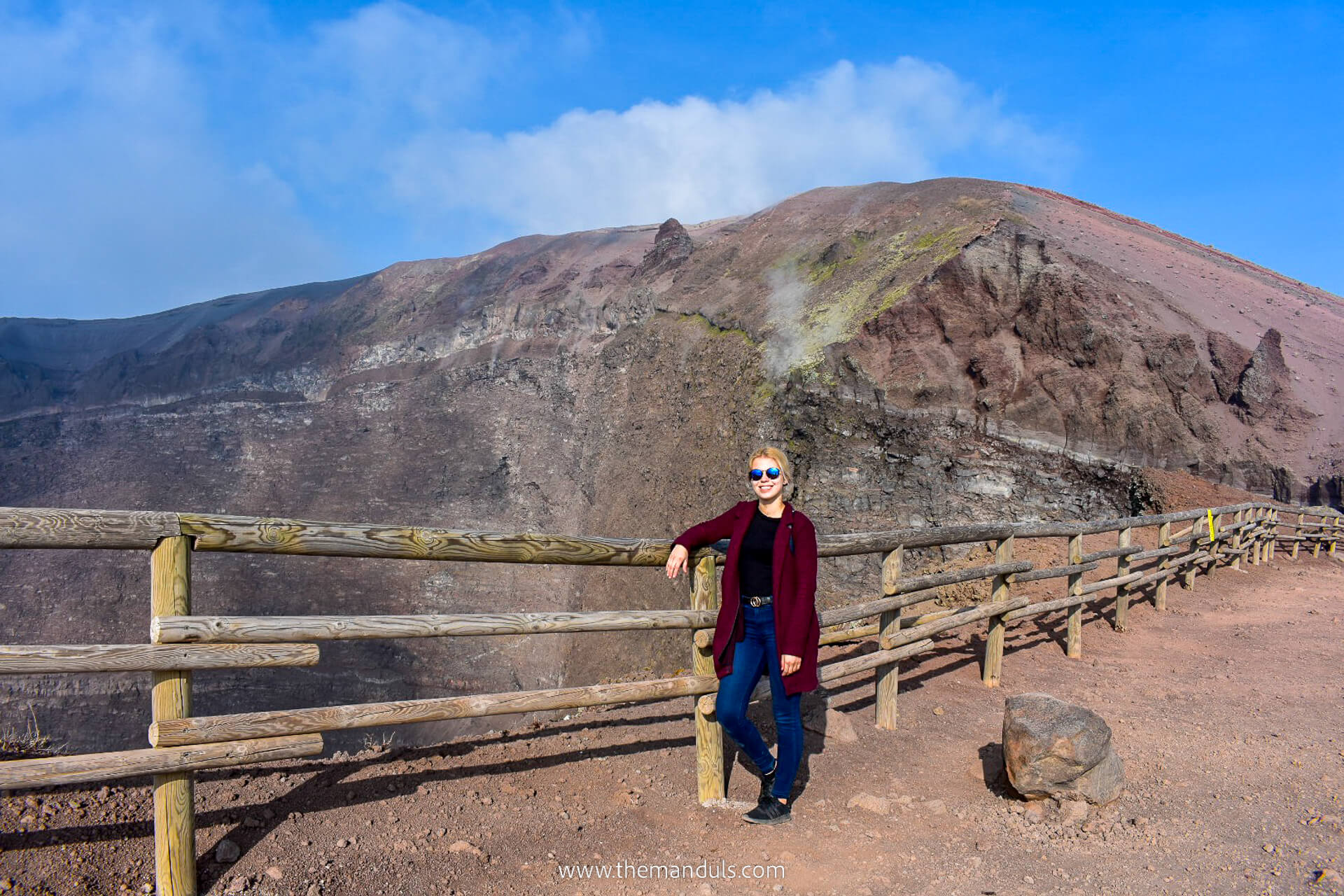
From the top, the views over the Bay of Naples are absolutely incredible — Nika told me that she still remembers seeing all the way to Capri on a perfectly clear day.
It’s currently only possible to visit the crater with pre-booked tickets, which include access to the top and a short guided tour. Due to low mobile signal near the entrance, we highly recommend booking your tickets in advance before arrival — otherwise, you may not be able to purchase them on-site.
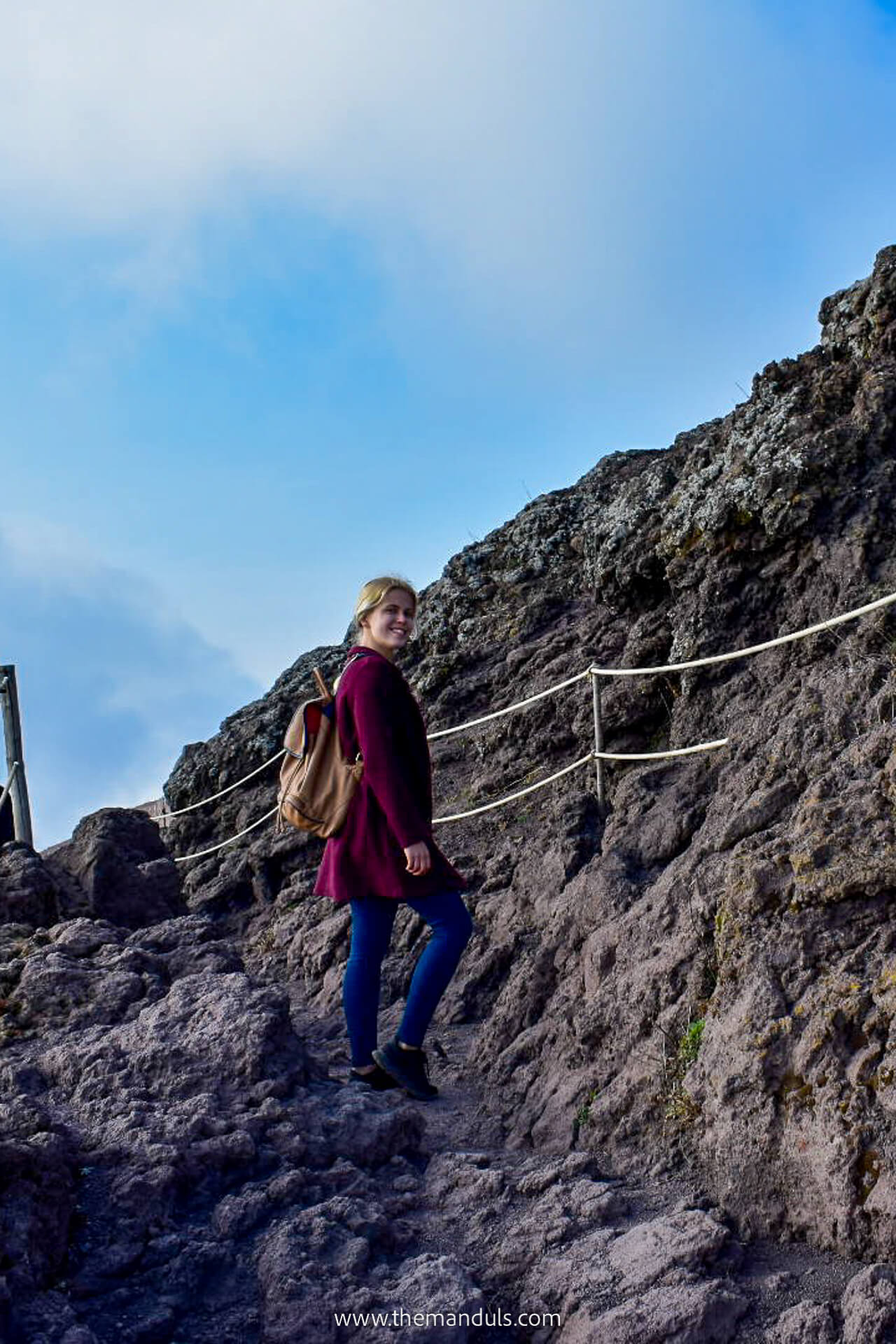
The hike to the crater took Nika around 45 minutes up and about 30 minutes back down, so you might count on these times, but it also depends on your own pace.
If you’d rather not worry about transport or logistics, we recommend a guided day trip that combines Pompeii and Mount Vesuvius with lunch and transfers included — it’s one of the easiest and most enjoyable ways to experience both in a single day.
Book your Pompeii and Mount Vesuvius guided tour with free cancellation up to 24 hours in advance.
11. Take a day trip to Pompeii or Herculaneum
Visiting Pompeii was one of those experiences that really stayed with us. It’s hard to describe what it feels like to walk through streets that were once buried under volcanic ash — it’s crazy, fascinating, and beautiful all at once. We spent a couple of hours exploring.

One of the most creepy yet unforgettable parts for us was seeing the casts of the bodies — people frozen in the exact positions they were in when the lava and ash struck. It’s haunting, yet incredibly powerful, a reminder of how life changed here suddenly nearly 2,000 years ago.
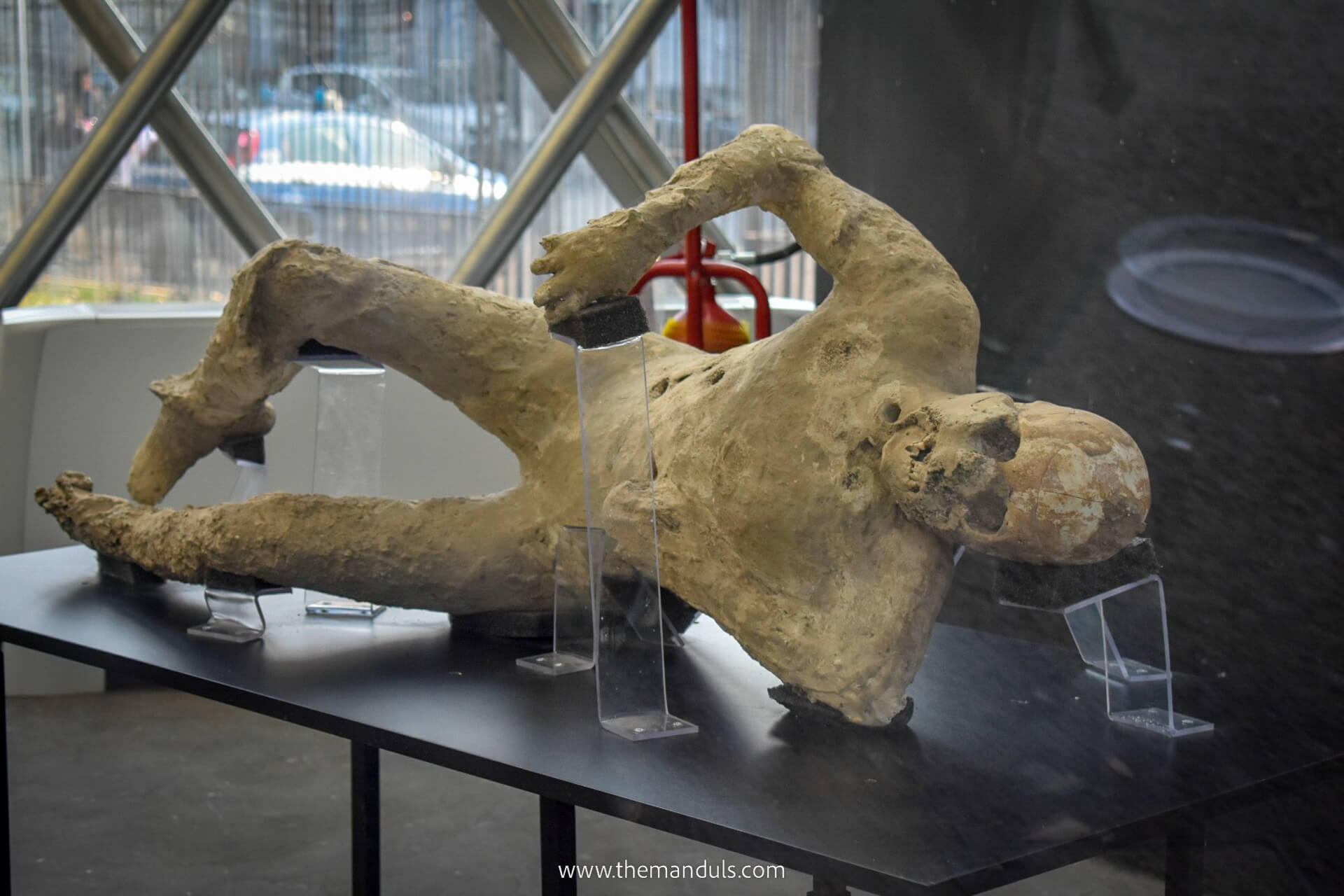
We recommend visiting either early in the morning or later in the afternoon to avoid the midday heat and crowds.
If you’re looking for something smaller and better preserved, Herculaneum is an excellent alternative. It’s quieter, more compact, and offers a slightly different perspective — many of the buildings still retain their original frescoes, mosaics, and even wooden furniture intact.

If you’re short on time or want to truly understand what you’re seeing, a guided tour makes a huge difference — you’ll learn stories and details you’d easily miss on your own.
To make the most of your visit, we highly recommend booking this Pompeii guided tour with an archaeologist. It includes your entry ticket and is led by a real archaeologist — you’ll walk through the ruins with someone who actually helped uncover them. It’s one of the best ways to experience Pompeii and truly understand what you’re seeing.
Book your Pompeii guided tour with free cancellation up to 24 hours in advance.
12. Visit Positano
We couldn’t miss visiting Positano — it had been on our bucket list long before we even arrived in Naples. To make the most of the day, we started early in the morning and took the train to Sorrento, where we spent an hour or two wandering around. From there, we bought a bus ticket to Positano — and that’s where the adventure really began.

The drive along the Amalfi Coast is breathtaking but also a little terrifying. The road is extremely narrow, twisting along steep cliffs that drop straight into the sea. It takes serious courage (and skill) to drive here, so we wouldn’t recommend renting a car unless you’re a very confident driver.
We actually loved taking the bus — the views were insane, and sitting on the right side of the bus gives you the best perspective of the coastline (or grab a front seat if you want to see the action up close).
Positano looks exactly like the postcards — maybe even better. It’s colorful, vibrant, and full of life, with pastel houses stacked up the hillside. It’s also one of the most famous coastal towns in Italy, and to be honest, it truly lives up to the hype.
Since you’re in Naples, it’s also worth planning a few days on the coast — you’ll find our full guide on where to stay on the Amalfi Coast super helpful for choosing the right base and hotels for your next leg.
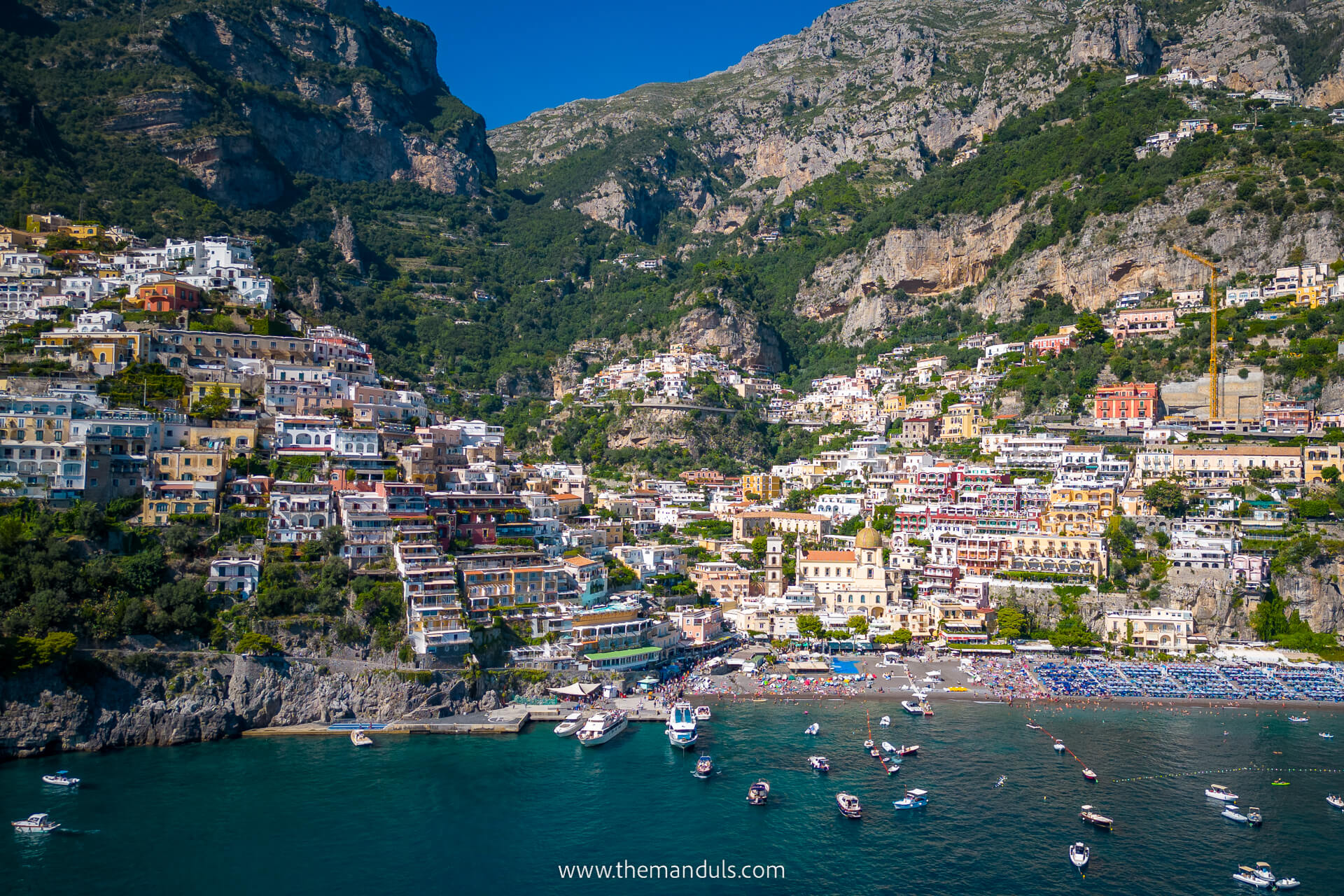
We spent our time wandering the narrow streets, stopping for gelato, buying a few souvenirs, and finally heading down to the beach to cool off. That’s when we got a little surprise — there’s only one narrow public stretch of sand where you can lay your towel for free, and finding space there was almost impossible.
It was packed, shoulder-to-shoulder with people, and we didn’t want to pay the high prices for sunbeds.
If you don’t mind spending a bit more, there are plenty of private beaches with sunbeds and umbrellas that offer much more comfort (and personal space). Prices vary depending on the section, but expect to pay around €25–€35 per person during peak season.
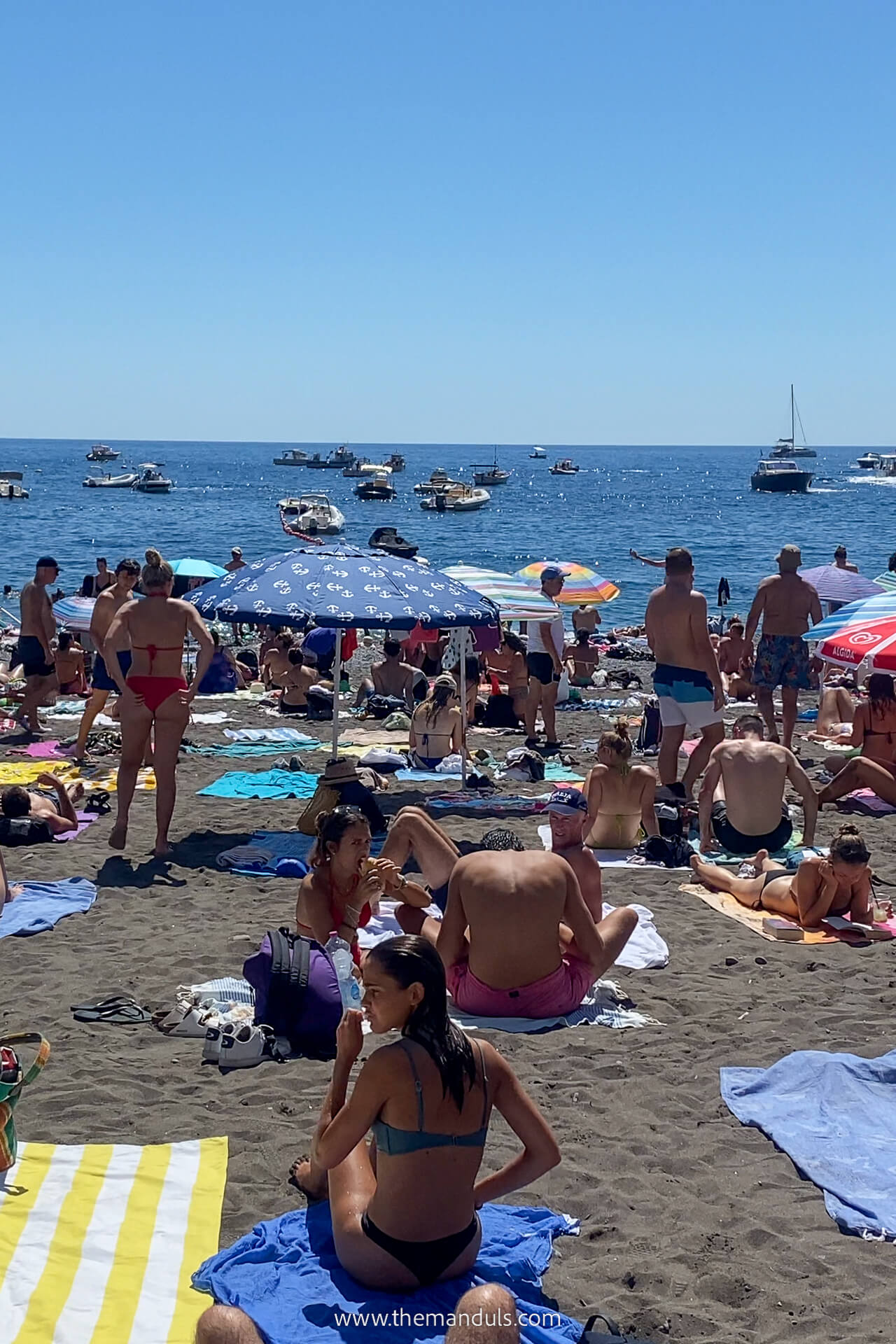
We recommend coming early in the morning if you want to enjoy Positano before the crowds, and bring comfortable shoes — every street here is either going uphill or downhill.
If you’d rather skip the transport stress and enjoy the coast in comfort, we highly recommend this small-group day tour from Naples to Sorrento, Positano & Amalfi.
13. Visit Amalfi
During our day trip to Positano and Sorrento, we also made a quick stop in Amalfi, but we didn’t have enough time to explore it properly — and that’s something we’d definitely change next time.
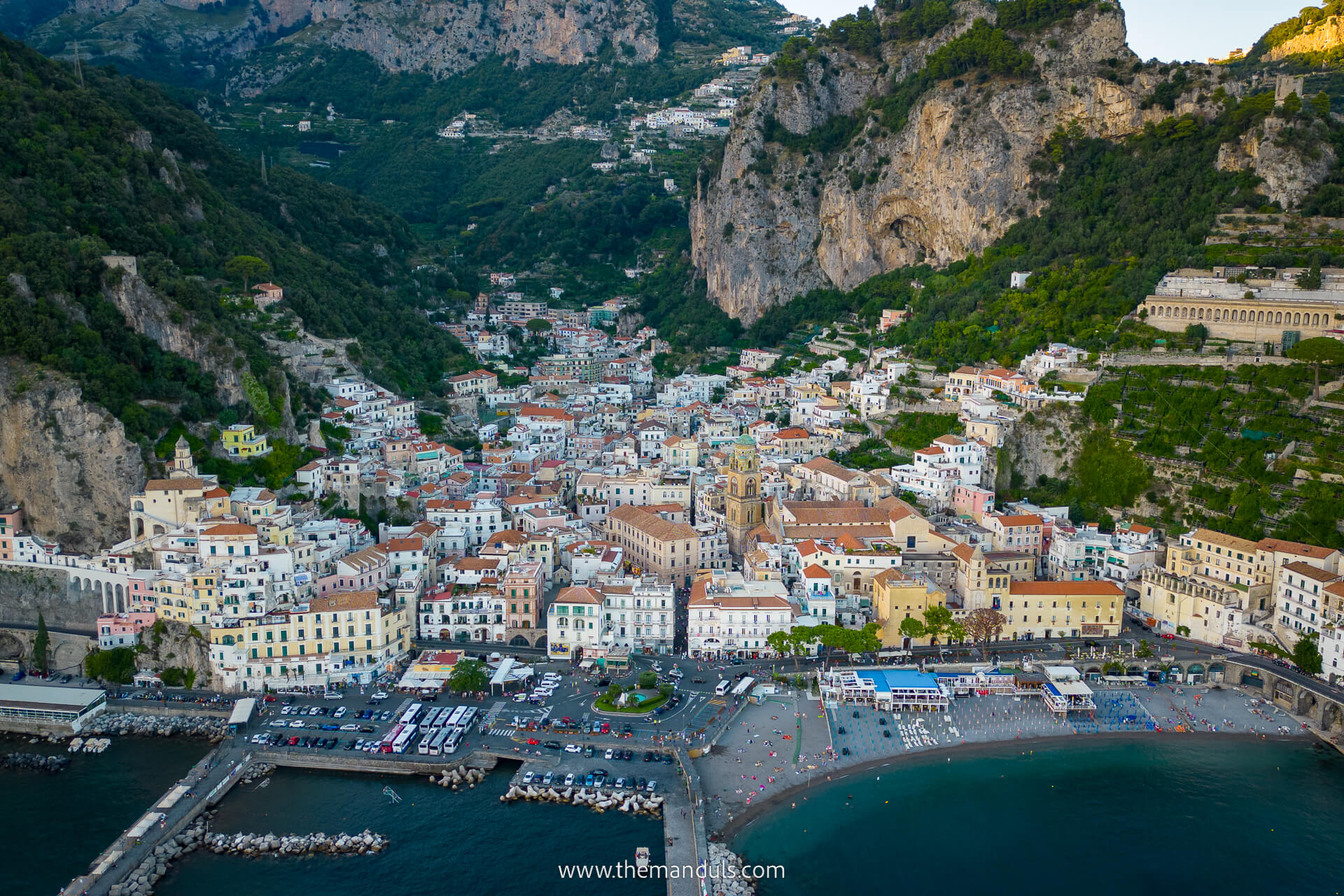
If we could redo it, we’d either dedicate a full day just to Amalfi or combine it with the nearby town of Salerno, which is another beautiful spot on the coast but far less crowded.
Amalfi feels different from Positano — smaller, more historic, and a little calmer. The highlight is the Duomo di Sant’Andrea, a stunning cathedral that dominates the main square with its black-and-white striped facade and steep staircase.

Around it, you’ll find cozy cafés, lemon shops, and plenty of places to enjoy a spritz while watching the people passing by. Once there, you’ll also notice lemon gelato shops on almost every corner — it’s a local specialty and an absolute must-try.
There’s also a public beach right in Amalfi that’s easy to access, and unlike in Positano, we had no trouble finding a spot to lay our towel down. It wasn’t crowded at all, which made it the perfect place to relax after walking around — we really appreciated the calmer vibe.
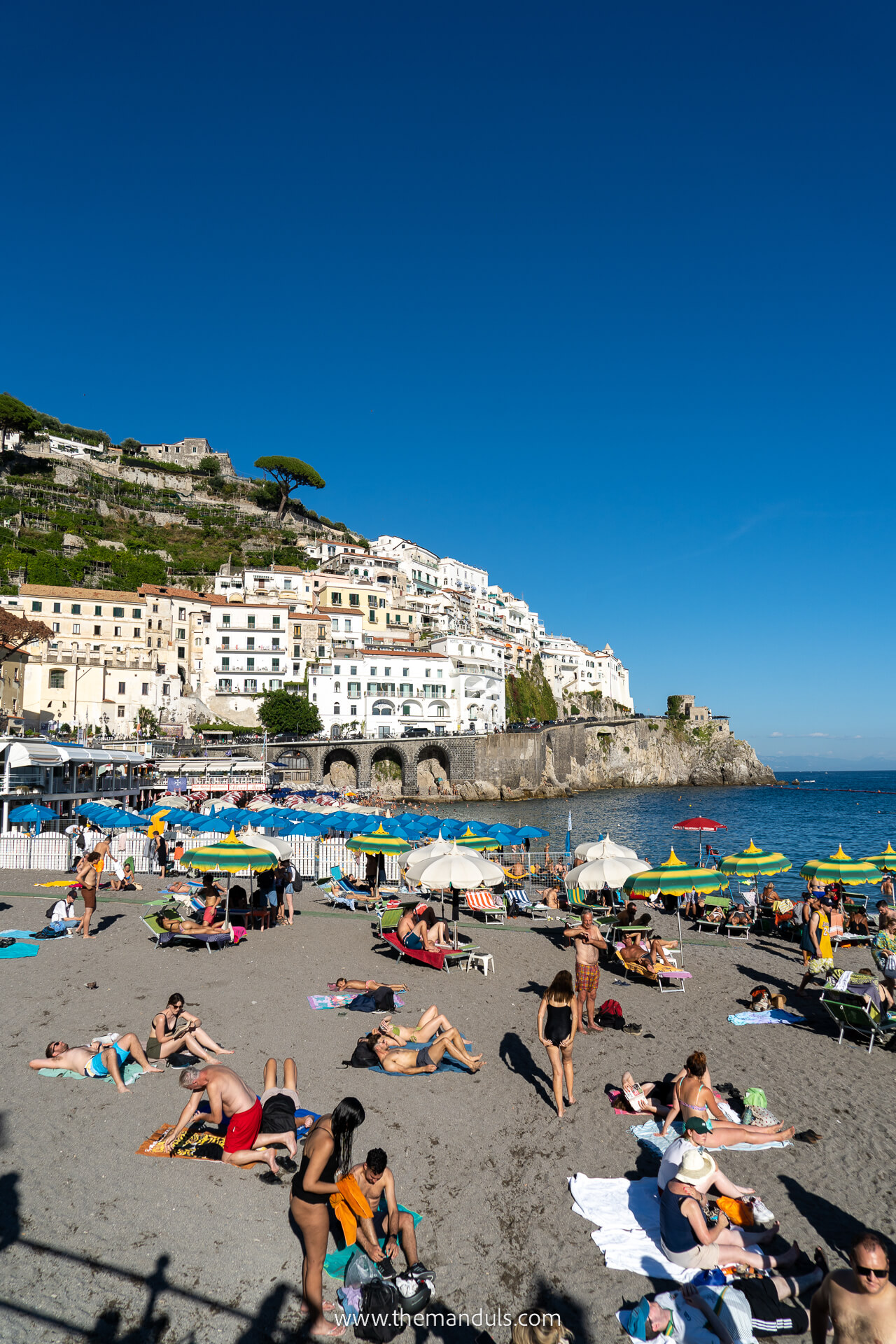
If you have extra time, consider visiting Salerno — it’s less touristy, more local, and a great base for exploring the Amalfi Coast without the crowds or high prices.
The city has a long seaside promenade, plenty of authentic restaurants, and easy ferry connections to Amalfi and Positano. It’s the kind of place where you can slow down, enjoy real Italian life, and still be just a short boat ride from all the main sights.
14. Take a day trip to Capri
Since there’s so much to see in and around Naples and we had limited time, we unfortunately didn’t make it to Capri — but we told ourselves we’ll definitely visit next time.
It’s one of those must-visit places that everyone keeps talking about, and the more we researched it afterward, the clearer it became that it’s worth dedicating at least a full day.
Capri is famous for its stunning cliffs, hidden coves, luxury boutiques, and panoramic viewpoints that look unreal even in photos. The island is also home to the iconic Blue Grotto, a glowing sea cave where sunlight reflects through the water, turning everything electric blue.
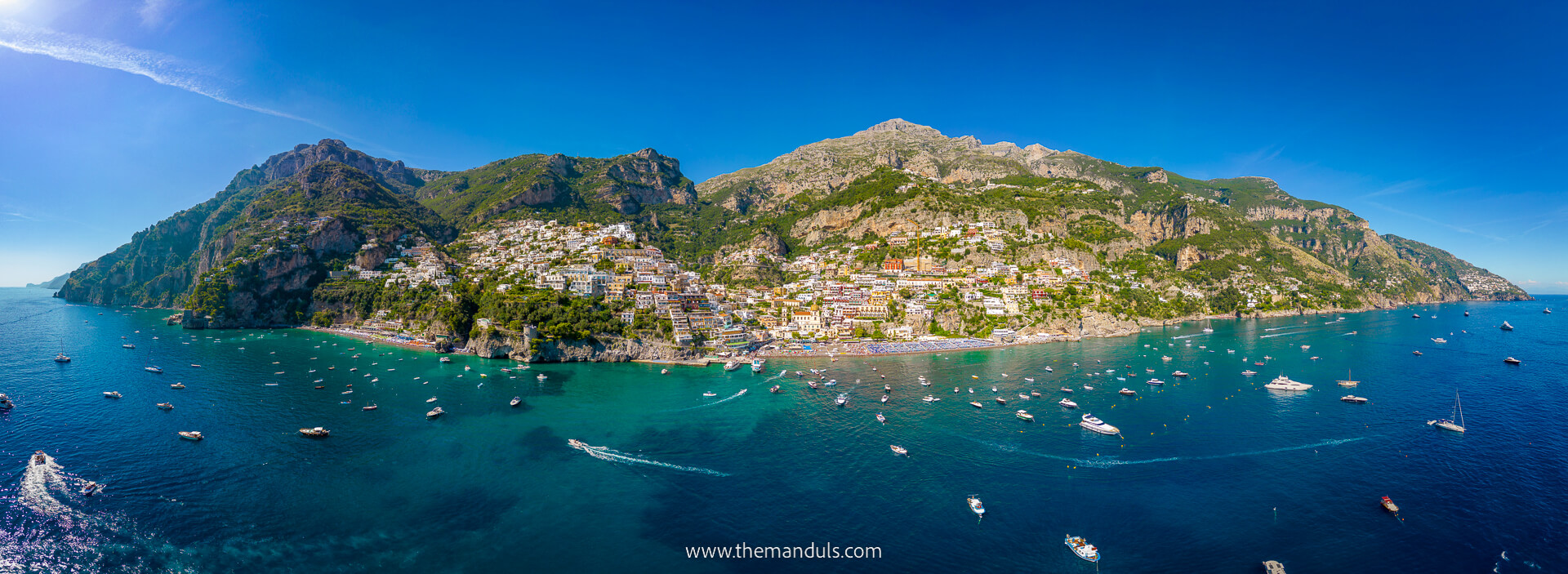
You can also visit Anacapri, a quieter village higher up the island known for its laid-back charm, chairlift views, and lemon gardens.
If you’re planning a visit, it’s best to go early in the morning to make the most of your time — ferries from Naples take about 50–60 minutes, and the island is easy to explore on foot or by local bus once you arrive.
If you’d like to experience Capri without worrying about transport or planning, we highly recommend this small-group day tour from Naples to Capri & Anacapri. It includes round-trip ferry tickets, a guided visit to both towns, and plenty of free time to enjoy the island.
Many travelers combine Naples with Rome on the same trip — if you’re heading there next, read our best things to do in Rome and where to stay in Rome guides to plan your visit easily.
Where to eat and drink
Naples is one of those cities where eating well is almost impossible to avoid — every corner smells like pizza, espresso, or freshly baked pastries.
Everywhere we go, we always check the highest-rated restaurants, cafés, and bars to make sure we experience something truly outstanding — and if you follow our tips below, you won’t be disappointed.
We didn’t manage to try every place on our list, but here are some great restaurants, cafés, and bars we recommend checking out on your trip.

Restaurants & Street Food
- Novita Street Food – Perfect for a quick bite between sightseeing stops. Expect simple but delicious Neapolitan classics like fried pizza, arancini, and fresh seafood served fast and hot.
- Trattoria Pizzeria Bella Napoli Centro – Chef dal 1990 – A cozy local spot serving authentic pizzas and homemade pastas in a relaxed, family-run setting.
- Il Piastrato – Great choice for dinner if you want something traditional but slightly more refined. Their pasta portions are generous, and the service is warm and welcoming.
- Signora Bettola – Napoli (Chiaia) – A modern trattoria with creative twists on local dishes, located in the stylish Chiaia district. Perfect for a relaxed evening meal paired with wine or an Aperol Spritz.

Cafés & Bars
- Il Rifugio Wine Bar Peppe Masiello. Spritz – Small, friendly bar with great cocktails and even better prices. Ideal for an early evening Aperol or Limoncello.
- Archeobar – Negroneria Napoletana – Known for their expertly mixed Negronis and cool vintage interior. A fun place to start (or end) the night.
- Sansone Coffee Artisan Microroastery & Specialty Coffee – If you’re into quality coffee, this spot is a gem. Great espresso, and even better cappuccino.
- Gran Caffè Cimmino – Classic Italian cafe atmosphere with professional baristas and great pastries. Stop here for a quick espresso the Neapolitan way — standing at the counter.
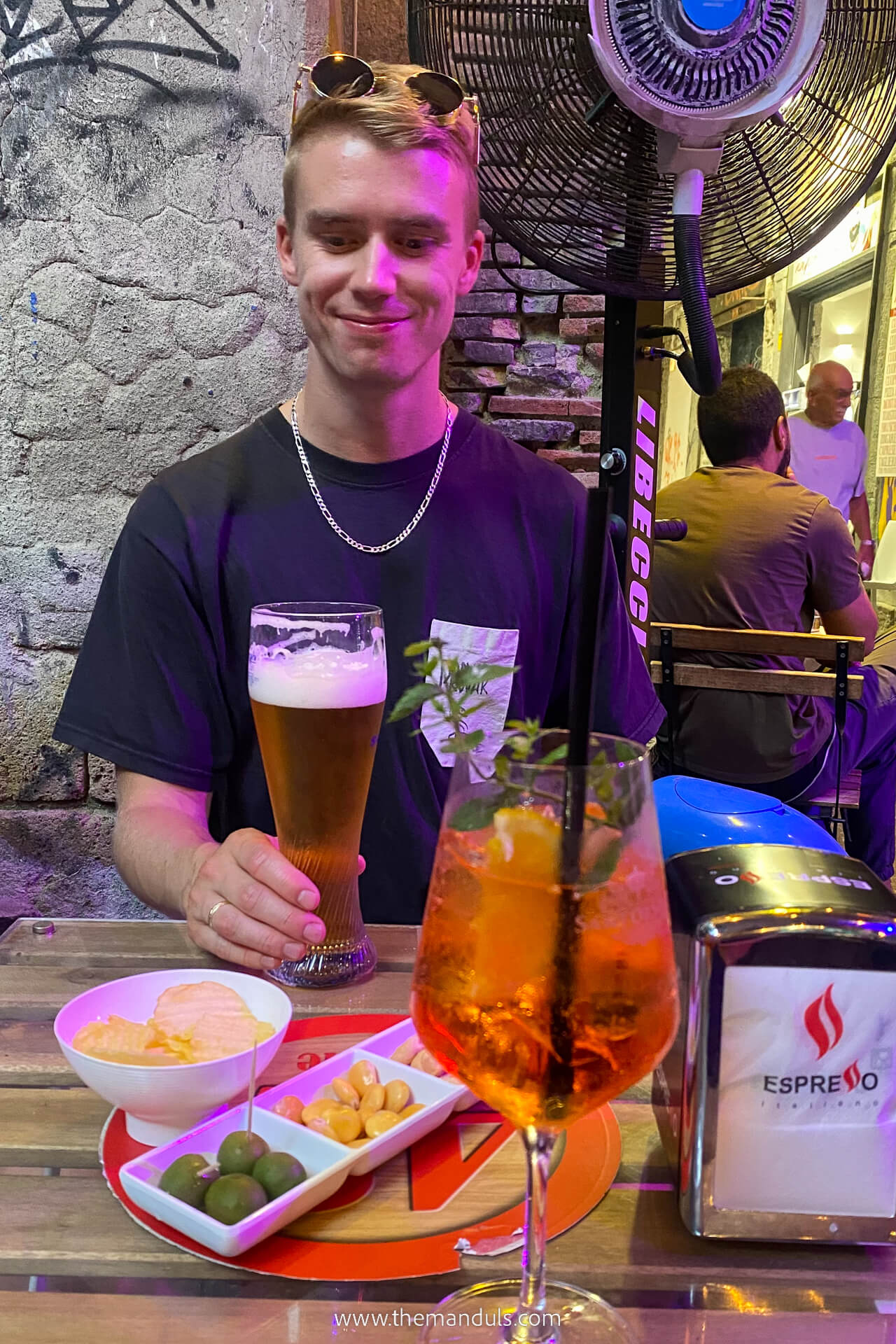
Heading north next? Don’t miss our best things to do in Venice guide — it’s one of our favorite cities in Italy. And if you’re still planning where to stay, we’ve also covered the best places to stay in Venice with personal recommendations and local tips.
How to get around
Getting around Naples is surprisingly easy once you get the hang of it — and honestly, walking is the best way to explore most of the city. The historic center is compact, full of narrow alleys and hidden corners you’d miss from a car. Just wear comfortable shoes — the cobblestones and stairs can be tough after a while.
For longer distances, use the metro (Line 1), which connects the main parts of the city, including the port, Piazza Dante, and Vomero Hill. Stations like Toledo and Municipio are worth visiting even on their own — they’re part of the famous Art Metro. A single ticket costs about €1.30 and is valid for 90 minutes on the metro, buses, and funiculars.
If you’re heading to nearby spots like Pompeii, Sorrento, or Herculaneum, the Circumvesuviana train from Napoli Garibaldi station is the easiest and cheapest way to go.
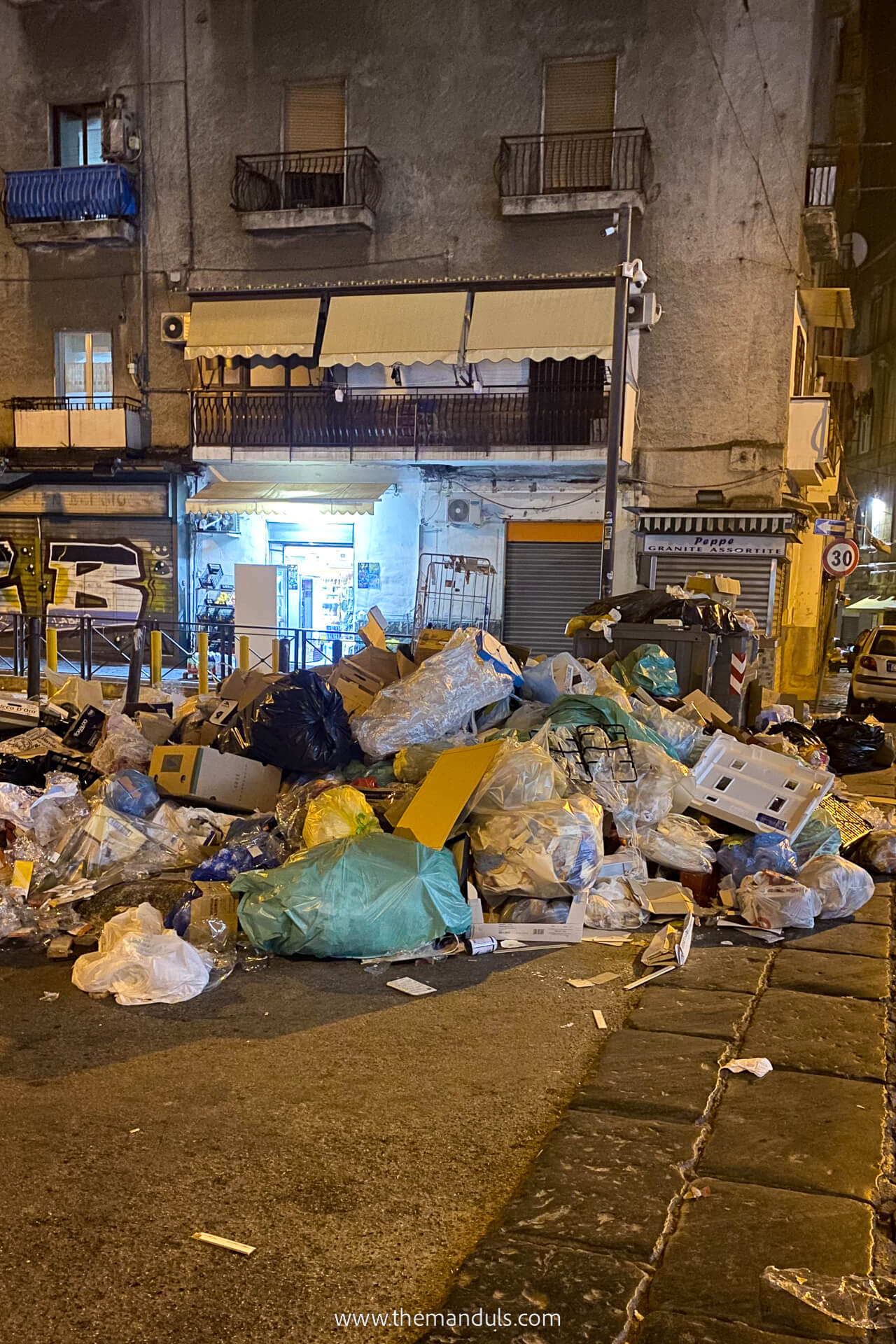
Best time to visit Naples
We visited Naples at the end of August, which is still peak season, so some places were packed with tourists — but honestly, that’s to be expected in Italy during summer.
The weather was hot and sunny every day, perfect for day trips to the coast or just wandering with a gelato in hand. Still, if we had to choose again, we’d probably come a little earlier or later in the season.
The best time to visit Naples is generally from April to early June and September to October. During these months, the weather is warm but not too hot, and you’ll find fewer crowds compared to midsummer.
Accommodation prices also drop significantly outside of peak season, so you can save quite a lot of money while still enjoying perfect sightseeing conditions. It’s also ideal for exploring the historic center, visiting Pompeii, or hiking around Mount Vesuvius without melting in the heat.
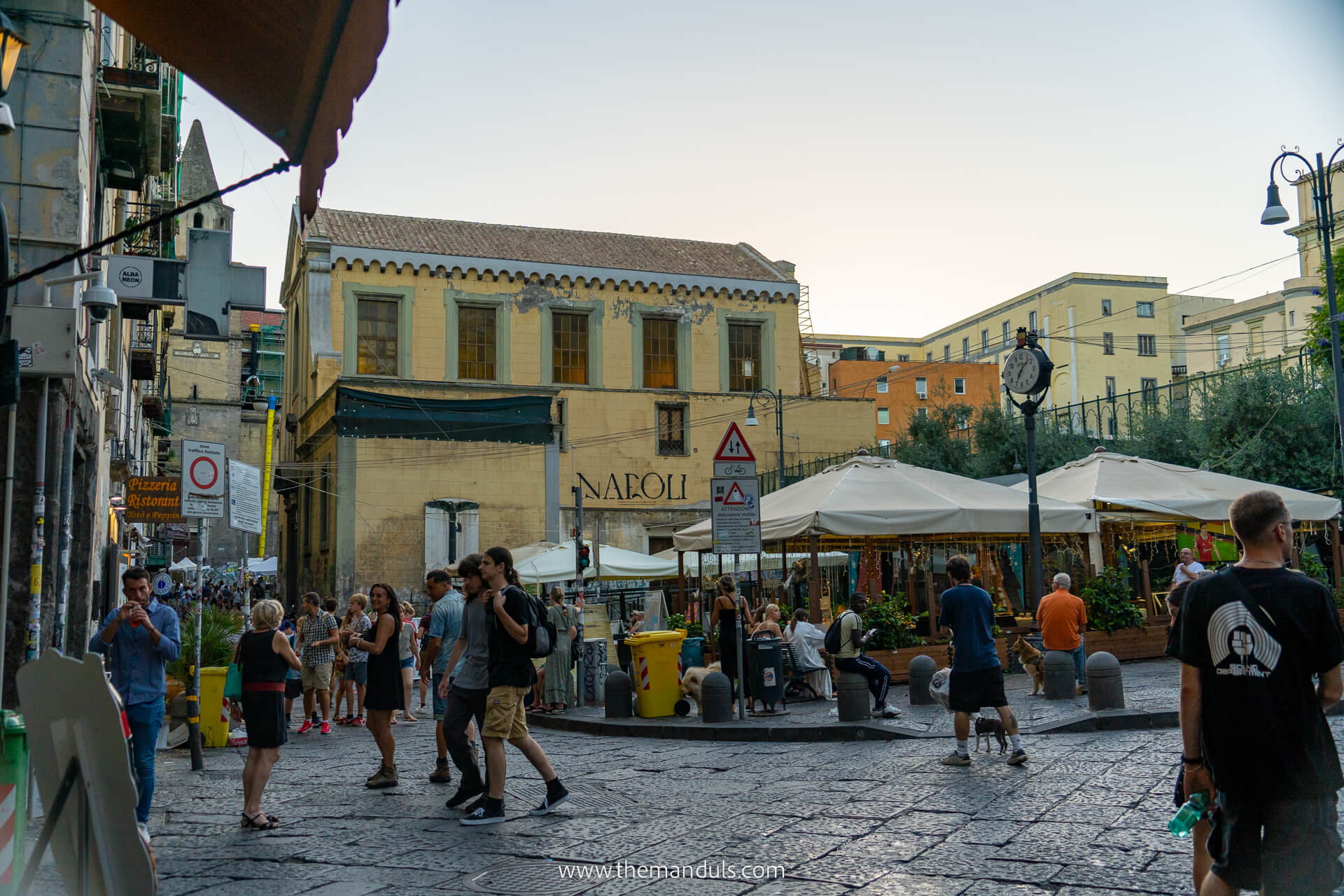
Quick tips & Local insights
- Watch your belongings: Naples has a lively atmosphere, but you should be aware about pickpockets, especially around train stations and crowded streets. We didn’t have any issues, but it’s worth being mindful.
- Don’t rent a car in the city: Traffic is chaotic, parking is a nightmare, and scooters seem to come from every direction. Use public transport or walk — it’s much easier.
- Bring cash: Many smaller cafés, pizzerias, and gelaterias still don’t accept cards, so having a bit of cash on hand saves trouble.
- Start your days early: This city gets busy fast, especially in summer. If you want to enjoy famous spots like Spaccanapoli or Piazza del Plebiscito without crowds, go in the morning.
- Try local drinks. Beyond Limoncello, look out for local wines from Mount Vesuvius — they’re surprisingly good and usually very affordable.

Final Thoughts
Our visit turned out to be one of the biggest surprises. We arrived by accident and left completely fascinated by the city’s raw energy, incredible food, and authentic atmosphere.
It isn’t polished — it’s chaotic, noisy, and imperfect — but that’s exactly what makes it so real and unforgettable.
If you come with an open mind, patience, and curiosity, you’ll see why this city wins people over so easily. Try the street food, talk to locals, explore beyond the main squares — that’s where Naples truly shines.
For us, it’s not if we’ll return, but when — next time, we’ll be back to finally climb Mount Vesuvius and visit Capri.

